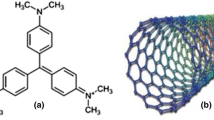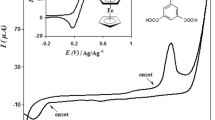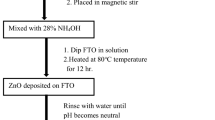Abstract
In this work, we investigated the effect of single walled carbon nanotubes (SWCNT) on the electrical and photovoltaic properties of methyl red (MR) dye based photoelectrochemical cell (PEC). MR dye based PEC with LiClO4 as ion salt were fabricated with and without mixing SWCNT. The cells were characterized through electrical and optical measurements. The performance of the devices changed drastically in presence of SWCNT. The transition voltage and trap energy of the cells were estimated from the steady-state dark current voltage (I-V) analysis. The transition voltage and trap energy decreased for MR dye cell in presence of SWCNT. Open circuit voltage (V oc), short circuit current (J sc), fill factor (FF) and power conversion efficiency (η) increased due to the addition of SWCNT. Further measurement of the transient photocurrent showed that the growth and decay of photocurrent was quite faster in presence of SWCNT. The photocurrent decay with time was fitted for both the cells and found to follow a power law relation which indicates dispersive transport mechanism with exponential trap states distributed in between lowest unoccupied molecular orbital (LUMO) and highest occupied molecular orbital (HOMO) levels. Possible interpretation is done on the lowering of trap energy with the photocurrent. These results suggest that SWCNT lowers the trap energy of the cells by providing efficient percolation pathways for the conduction of charges. It is expected that due to lowering of trap energy the residing time of the free carriers within the traps decreases. In other words, it may also be said that the charge recombination decreases. These factors affect the overall conduction of charges and improve the electrical and photovoltaic properties.
Similar content being viewed by others
References
Grätzel M. Photoelectrochemical cells. Nature, 2001, 414(6861): 338–344
Hagberg D P, Marinado T, Karlsson K M, Nonomura K, Qin P, Boschloo G, Brinck T, Hagfeldt A, Sun L. Tuning the HOMO and LUMO energy levels of organic chromophores for dye sensitized solar cells. Journal of Organic Chemistry, 2007, 72(25): 9550–9556
Haldar A, Maity S, Manik N B. Electrical and photovoltaic characterisations of methyl red dye doped solid-state photoelectrochemical cell. Ionics, 2009, 15(1): 79–83
Burke D J, Lipomi D J. Green chemistry for organic solar cells. Energy & Environmental Science, 2013, 6(7): 2053–2066
Hardin B E, Snaith H J, McGehee M D. The renaissance of dyesensitized solar cells. Nature Photonics, 2012, 6(3): 162–169
Li G, Zhu R, Yang Y. Polymer solar cells. Nature Photonics, 2012, 6 (3): 153–161
Islam M R, Maity S, Haldar A, Manik N B, Basu A N. Photocurrent growth and decay behaviour of crystal violet dye-based photoelectrochemical cell in photovoltaic mode. Ionics, 2012, 18(1–2): 209–214
Singh P K, Jadhav N A, Mishra S K, Singh U P, Bhattacharya B. Application of ionic liquid doped solid polymer electrolyte. Ionics, 2010, 16(7): 645–648
Fredin K, Nissfolk J, Boschloo G, Hagfeldt A. The influence of cations on charge accumulation in dye sensitized solar cells. Journal of Electroanalytical Chemistry, 2007, 609(2): 55–60
Shuttle C G, Treat N D, Douglas J D, Fréchet J M J, Chabinyc M L. Deep energetic trap states in organic photovoltaic devices. Advanced Energy Materials, 2012, 2(1): 111–119
Walker A B, Peter L M, Martínez D, Lobato K. Transient photocurrents in dye-sensitized nanocrystalline solar cells. CHIMIA International Journal for Chemistry, 2007, 61(12): 792–795
Li C, Duan L, Li H, Qiu Y. Universal trap effect in carrier transport of disordered organic semiconductors: transition from shallow trapping to deep trapping. Journal of Physical Chemistry C, 2014, 118(20): 10651–10660
Montero J M, Bisquert J. Trap origin of field-dependent mobility of the carrier transport in organic layers. Solid-State Electronics, 2011, 55(1): 1–4
Carr J A, Chaudhary S. On the identification of deeper defect levels in organic photovoltaic devices. Journal of Applied Physics, 2013, 114(6): 064509
Mandoc M M, Kooistra F B, Hummelen J C, de Boer B, Blom P W M. Effect of traps on the performance of bulk heterojunction organic solar cells. Applied Physics Letters, 2007, 91(26): 263505
Dey S K, Islam M R, Manik N B, Basu A N. Study on the effect of trap levels on steady-state dark I–V characteristics in Safranine-Tbased solid-state thin film photoelectrochemical cell. Journal of Materials Science Materials in Electronics, 2002, 13(5): 249–252
Islam MR, Saha S, Manik N B, Basu A N. Transient current study in Safranine-T dye based organic photo-electrochemical cell using exponentially distributed trap assisted charge transport model. Indian Journal of Physics, 2012, 86(12): 1101–1106
Chen J, Yan Y, Lin K. Effects of carbon nanotubes on dye-sensitized solar cells. Journal of the Chilean Chemical Society, 2010, 57(5B): 1180–1184
Hosni M, Kusumawati Y, Farhat S, Jouini N, Pauporté T. Effects of oxide nanoparticle size and shape on electronic structure, charge transport and recombination in dye-sensitized solar cell photoelectrodes. Journal of Physical Chemistry C, 2014, 118 (30): 16791–16798
Ausman K D, Piner R, Lourie O, Ruoff R S. Organic solvent dispersions of single-walled carbon nanotubes: towards solutions of pristine nanotubes. Journal of Physical Chemistry B, 2000, 104 (38): 8911–8915
Lee K M, Hu C W, Chen H W, Ho K C. Incorporating carbon nanotube in a low-temperature fabrication process for dye-sensitized TiO2 solar cells. Solar Energy Materials and Solar Cells, 2008, 92 (12): 1628–1633
Somani S P, Somani P R, Umeno M. Carbon nanotube incorporation: a new route to improve the performance of organic-inorganic heterojunction solar cells. Diamond and Related Materials, 2008, 17 (4–5): 585–588
Chakraborty S, Manik N B. Effect of COOH-functionalized SWCNT addition on the electrical and photovoltaic characteristics of Malachite Green dye based photovoltaic cells. Journal of Semiconductors, 2014, 35 (12): 124004
Maity S, Haldar A, Manik N B. Effect of plasticizer on Safranine-Tdye- based solid-state photo electrochemical cell. Ionics, 2008, 14 (6): 549–554
Alam A, Sachar S, Puri N, Saxena R K. Interactions of polydispersed single-walled carbon nanotubes with T cells resulting in downregulation of allogeneic CTL responses in vitro and in vivo. Nanotoxicology, 2013, 7(8): 1351–1360
Haldar A, Maity S, Manik N B. Effect of back electrode on photovoltaic properties of crystal-violet-dye-doped solid-state thin film. Ionics, 2008, 14(5): 427–432
Mahmoud M A, Poncheri A, Badr Y, Abd El Wahed M G. Photocatalytic degradation of methyl red dye: research letter. South African Journal of Science, 2009, 105(7–8): 299–303
Buitrón G, Quezada M, Moreno G. Aerobic degradation of the azo dye acid red 151 in a sequencing batch biofilter. Bioresource Technology, 2004, 92(2): 143–149
Yang J, Shen J. Effects of discrete trap levels on organic light emitting diodes. Journal of Applied Physics, 1999, 85(5): 2699–2705
Shen J, Yang J. Physical mechanisms in double-carrier trap-charge limited transport processes in organic electroluminescent devices: A numerical study. Journal of Applied Physics, 1998, 83(12): 7706–7714
Mark P, Helfrich W. Space-charge-limited currents in organic crystals. Journal of Applied Physics, 1962, 33(1): 205–215
Author information
Authors and Affiliations
Corresponding author
Additional information
Sujata Chakraborty received her B.Sc. degree from the Department of Physics at Cotton College under Gauhati University, India in 2009 and obtained her M.Sc. degree from the same university in 2011. She is now a Ph.D. student at the Department of Physics, Jadavpur University. Her research interests include development and characterization of photovoltaic devices using semiconducting conjugated polymers and organic dyes.
Nabin Baran Manik is an associate professor in Department of Physics, Jadavpur University, Kolkata, India. He received his Ph.D. degree from Jadavpur University, Kolkata, India, in 1998 and right after that he joined as lecturer in Physics Department of the same university. In 2004, he was awarded Better Opportunities for Young Scientists in Chosen Areas of Science and Technology (BOYSCAST) Fellowship of Department of Science and Technology (DST), Govt. of India and did his Post Doctoral work at Leibniz-Institut für Festkörper- und Werkstoffforschung (IFW), Dresden, Germany. He is working in the area of development of photovoltaic devices using semiconducting conjugated polymers and organic dyes, low temperature instrumentation, characterization of optoelectronics devices at low temperature. Several students have completed their Ph.D. under his supervision. Different research projects from different funding agencies were undertaken by him. He had also delivered invited talk in different national and international conference. He has different publications both at national and international journals some of which are available in his website: www.nbmanik.in.
Rights and permissions
About this article
Cite this article
Chakraborty, S., Manik, N.B. Improvement of electrical and photovoltaic properties of methyl red dye based photoelectrochemical cells in presence of single walled carbon nanotubes. Front. Optoelectron. 8, 289–297 (2015). https://doi.org/10.1007/s12200-015-0527-6
Received:
Accepted:
Published:
Issue Date:
DOI: https://doi.org/10.1007/s12200-015-0527-6




